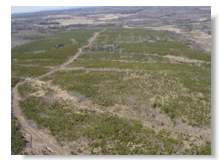
Basic Forest Fire Suppression Course - Online Lessons
LESSON 3 - EFFECTS OF WEATHER, TOPOGRAPHY AND FUELS ON FIRE BEHAVIOR
Wildland fire fuels consist of any vegetation that will burn (living or dead), from grasses and leaves to shrubs and trees.

There are fuel properties which will dictate how fire will behave and each can provide clues about what that behaviour is going to look like. Each will be described in the following lesson.
(1) Fuel size
(2) Fuel arrangement
(3) Fuel volume
(4) Fuel type
(5) Fuel condition
(6) Fuel moisture
(7) Chemical content
Fuel size describes whether the fuels are coarse or fine.
Fine fuels are small twigs, leaves, needles, grasses, ferns or any other light weight / small diameter material. Coarse fuels consist of larger combustible materials such as: logs, stumps, trees, large limbs, treetops.
Size relates directly to the amount of heat required for fuels to reach ignition temperature. Fine fuels have more exposed surface area in relation to their volume and consequently dry out faster than larger fuels. Fine fuels burn rapidly and significantly contribute to ignition and rate of spread.
Coarse fuels require more heat for ignition and burn slower than fine fuels. Coarse fuels continue to burn after fine fuels have been consumed.
> Proceed to Fuel Arrangement >